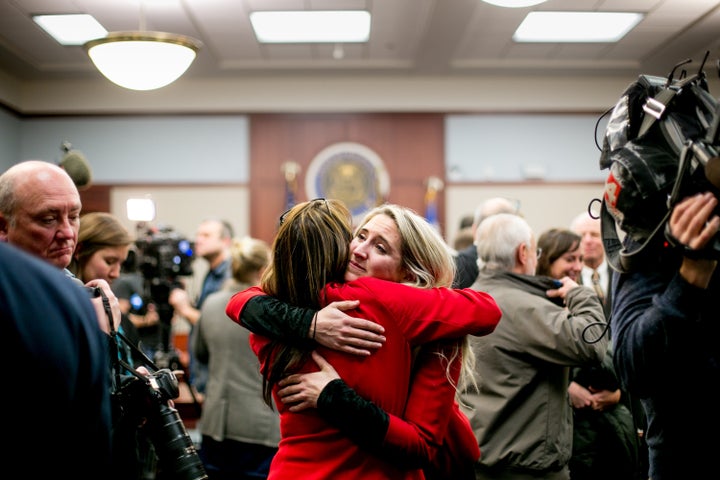
“We are Jane Does no more.”
On Jan. 24, gymnast Kaylee Lorincz directed that statement at former Michigan State University and USA Gymnastics team doctor Larry Nassar. She stood up at a podium, the 155th woman to do so in a Lansing, Michigan courtroom over the past week, and faced both the man she says abused her and Judge Rosemarie Aquilina, the judge who held that man’s fate in her hands.
After years of being ignored, disbelieved and silenced, Lorincz and the more than 160 other women Nassar victimized were finally heard.
So often, our justice system fails victims of sexual violence, but in Aquilina’s courtroom, 156 women spoke unencumbered as the world watched. Nassar, who pleaded guilty to seven counts of criminal sexual conduct, was sentenced on Wednesday to serve 40 to 175 years in prison. (He will be sentenced for three more counts of criminal sexual conduct in another court on Jan. 31.) Media outlets like The New York Times, CNN, ESPN and HuffPost covered Nassar’s case for more than a year before he entered a plea. The number of public accusers rose rapidly in the meantime ― from two to 16 to 100 to 140.
But even after months of media coverage, many of the victims felt they were being ignored. They felt as though the public, despite being in the midst of a #MeToo moment, did not care about the stories of female athletes, even when those female athletes formed an army of more than 160 survivors.
“I haven’t sensed the outrage,” Nassar survivor Larissa Boyce told HuffPost’s Alanna Vagianos just days before the disgraced doctor’s sentencing began.
But as woman after woman stood up in that courtroom and began telling her story, something clicked. Perhaps it was the volume of stories ― 156 from victims, and more from coaches and family members. Or maybe it was the simplicity of the setting that got the public to pay attention ― a camera in a courtroom focused on each survivor as she spoke, cutting away only for an occasional glance at Nassar or the judge.
The format practically demanded that we listen to each person’s words unedited, resisting “hot takes” and sloppy commentary. Those of us who watched were forced to absorb each word spoken, no matter how unsettling or painful or heart-wrenching or infuriating.
“After years of being made to feel isolated, silent and small, Nassar’s survivors had, as Raisman predicted, become “a force.””
The first survivor to deliver a victim impact statement was Kyle Stephens, a former family friend of Nassar’s. Stephens was abused from the age of 6, and when she told her parents at age 12, they didn’t believe her.
“Larry Nassar wedged himself between myself and my family, and used his leverage as my parents’ trusted friend to pry us apart until we fractured,” she said. “I was 12 years old when I told my family, ‘When Larry rubs my feet, he uses his penis.’ My parents confronted him and he denied any such action… My parents chose to believe Larry Nassar over me.”
Many of the women who spoke after Stephens described being confronted with authority figures who did not listen to or believe their accounts of the abuse they had experienced. At least six women reported Nassar’s actions to administrators at Michigan State University. All were dismissed.
One of those women was Boyce, a former gymnast who said she told MSU coach Kathie Klages in 1997 that Nassar had touched her inappropriately, and that Klages replied that she must have misunderstood the procedure. A 2014 MSU Title IX investigation into Nassar’s conduct reached a similar conclusion: that there was no wrongdoing on the doctor’s part, because, according to the Detroit Free Press, “The investigator determined that the woman likely misinterpreted what Nassar did because she didn’t understand the ‘nuanced difference’ between an appropriate osteopathic medical procedure and sexual assault.”
“I knew that he abused me,” said gymnast Amanda Thomashow during her victim impact statement. “I reported it. Michigan State University had the audacity to tell me I did not understand the difference between sexual assault and a medical procedure.”

At every turn, these young women were considered to be unreliable narrators of their own experiences. And the result was that a predator had access to a steady stream of young women to abuse for more than two decades.
After all, who would believe a girl ― or even a handful of girls ― over a respected, decorated, beloved doctor? As Olympic gymnast Aly Raisman explained, “From the time we were little, we are taught to trust doctors.”
And despite the fact that Nassar consistently made Raisman feel “uncomfortable,” she says she “felt guilty” for doubting his authority.
“I assumed I was the problem for thinking badly of you,” she stated.
Research has shown that when women report being in pain, they are more likely than men to be undertreated for that pain. Similarly, when women come forward and say they have experienced sexual violence, they are often doubted. Doctors, especially male ones, are assumed to be trustworthy. Young women aren’t even considered experts on their own internal lives.
The phrase “believe women” only exists because the default has traditionally been not to.
But for women to be believed, they must first be heard. Thanks to Judge Aquilina, Larry Nassar’s victims were. It was Aquilina who decided that she would give time to any accuser who wanted to come to Michigan and speak. The court initially expected that 88 women would give statements. But as the week went on, more women decided that they, too, wanted their day in court and their chance to face their abuser. They had become a collective ― an “army of survivors.”
It was also Aquilina who made the decision to directly address every woman who gave a statement, looking them in the eye and thanking them for being there. She often added assurances that their testimony would matter. We tend to think of courtrooms as cold, methodical, legal places. Aquilina’s courtroom was full of emotion and empathy, at least for Nassar’s victims.
“People will listen to you. I’ve listened to you,” she told Olympian Jordyn Wieber. “You are really very strong, not just as an athlete; as a woman, as a survivor.”
(The judge has also faced criticism for crossing a line in the commentary she directed to Nassar himself.)
Since the 1991 Supreme Court case Payne v. Tennessee, the right of victims to deliver impact statements in front of the court has been widely recognized. But rarely does the public get to see those statements delivered.
“Victims testify every day in every courtroom about the harms they have suffered at the hands of perpetrators,” said Jennifer Gentile Long, CEO of AEquitas: The Prosecutors’ Resource on Violence Against Women. “In many ways the proceedings [over the past week] gave a voice to all of those victims.”
And Nassar’s victims’ words reverberated far beyond the courtroom, even making their way onto signs at Women’s Marches across the nation.
“Little girls don’t stay little forever. They grow into strong women that destroy your world,” read one sign, quoting Stephens.
“We are here, we have our voices and we are not going anywhere,” read another.
A third, cheekier sign simply stated: “What Aly Raisman said.”
After years of being made to feel isolated, silent and small, Nassar’s survivors had, as Raisman predicted, become “a force.”
